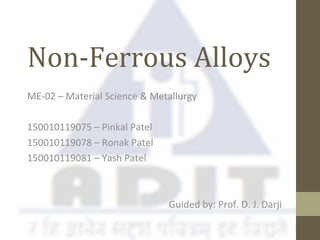Non ferrous alloys.ppt
- 1. Non-Ferrous Alloys ME-02 â Material Science & Metallurgy 150010119075 â Pinkal Patel 150010119078 â Ronak Patel 150010119081 â Yash Patel Guided by: Prof. D. J. Darji
- 2. Non-Ferrous Alloys âĒ As the name suggests, the material which do not contain iron as major element are known as Non - Ferrous materials. 1.Aluminium 2.Copper 3.Tin 4.Lead 5.Magnesium 6.Zinc 7.Titanium âĒ And alloys of these metals.
- 3. Aluminium & aluminium alloys Pure Al Al-alloys Powder aluminium Deformable Cast alloys alloys Heat- Non heat- Heat- Non heat- treatable treatable treatable treatable Partial solubility No solubility Partial solubility No solubility
- 4. Aluminium alloys Solubility 1) Al-Cu-Mg-alloys (duraluminium) Cu â 5,7% 2) Al-Cu-Mg-Si-alloys (forgable) Mg â 14,9% 3) Al-Mg-Si-alloys (corrosion resistance) 4) Al-Zn-Mg-Cu-alloys (high strength) 5) Al-Cu-Mg-Ni-Fe-alloys (heat resistance) Rm â 500 N/mm2 ; Rp0,2 â 390 N/mm2 ; A â 25%
- 5. Copper and copper alloys Pure Cu Cu-alloys Brasses Bronzes Cupronickels Deformable Cast Deformable Cast alloys alloys alloys alloys âĒ Moderate strength in the pure state âĒ Malleable and ductile âĒ Very good electrical and thermal conductor âĒ Good corrosion resistance âĒ Alloys with Zinc to give brass âĒ Alloys with Tin and others to make bronze
- 6. Copper alloys Cu-Ni alloys (â 50% Ni) - permanent CTE (constantan) â 45% Ni - corrosion resistant (Ni+Fe+Mn) â 30% Ni Cu with other elements - bronzes - Cu-Sn (tin bronzes) - Cu-Sn-P (phosphor bronzes) - Cu-Pb (lead bronzes) - Cu-Al (aluminium bronzes) Cu - 25% Ni (coin melhior, cupronickel) Cu - 10-20% Ni + 20-35% Zn (new silver, alpaca) -Cu-Si (silicon bronzes) -Cu-Be (beryllium bronzes)
- 7. Lead and lead alloys âĒ High Density âĒ Corrosion Resistant âĒ Malleable, but not ductile âĒ Very soft and weak
- 8. Magnesium and magnesium alloys Pure Mg Tm â 649 °C Density â 1740 kg/m3 (lightest among the engineering materials) Mg-alloys - Mg â Mn (up to 2,5 %) - Mg â Al â Zn (up to 10 % Al, 5 % Zn) Heat treatment of Mg-alloys Similar to Al-alloys Quenching + age hardening (NA, AA â MgZn2, Mg4Al3 jt) â Rm â 20 âĶ 30 %
- 9. Magnesium alloys Designation âĒ deformable (ex MgMn2) âĒ cast alloys (ex designation MCMgAl8 / material No. MC21110) Deformable Mg-alloys Mg cast alloys (EN173) Designation Rm Rp0,2 N/mm 2 A % Applications MgMn2 MgAl8Zn 200 145 310 215 15 6 Corrosion resistant, weldable cold formable; conteiners, car , aircraft and machine manufacturing MCMgAl8Zn1 MCMgAl6 MCMgAl4Si 240 90 190-250 120-150 200-250 120-150 8 4-14 3-12 Good castability. Dynamically loadable. Car and aircraft manufacturing.
- 10. Zinc and zinc alloys Pure Zn Tm â 419 °C Density â 7140 kg/m3 Good corrosion resistance Zn- alloys ____________________________________ Zn â Al Precision casting material Zn â Al â Cu Bearing alloy material Designation Material No. ex ZnAl8Cu1 ZP0810 Z â Zn-alloy P â casting first two numbers â Al%, 3.â Cu%, 4.âT- rest âĒ No structural engineering uses in pure state âĒ Used as sacrificial anodes to protect steel. âĒ Used as an alloy with copper to produce brass âĒ Used to corrosion coat steel by: âĒ Galvanising or âĒ Plating
- 11. Zinc cast alloys Designation Rm N/mm 2 Rpo,2 N/mm 2 A % HB Application ZnAl4 (ZP3) 280 200 10 83 Excellent castability, ZnAl4Cu1 (ZP5) 330 250 5 92 machinability; ZnAl8Cu1 (ZP8) 370 220 8 100 Universal applications: ZnAl11Cu1 (ZP12) 400 300 5 100 deep-draw and blow molds for plastics ZnAl27Cu2 (ZP27) 425 300 2,5 120
- 12. Titanium and titanium alloys Pure Ti Tm â 1660 °C Density â 4540 kg/m3 Very active to O, C, N â 2x hardnes increase Ti-alloys, classification Ti â Al â alloys (4âĶ6 % Al) â Îą-alloys Ti â Al â Cr, V, Cu, Mo - alloys â Îą + Îē-alloys Ti â Al â Mo, Cr, Zr - alloys â Îē-alloys Heat treatment of Tialloys Heating up to Îē-area (850âĶ950 °C) and cooling â martensitic transformation. Ageing (450âĶ600 °C) â max effect by Îē-stabilisators (Cr, Mn, Fe, Ni, Cu, Si) Additional heat treatment â nitriding (750âĶ900 HV)
- 13. Titanium alloys Designation HB Rm N/mm 2 Rpo,2 N/mm 2 A % Applications Ti 1âĶ3 120- 170 290- 590 180- 320 30- 18 Weldable, machinable and cold formable. Ti1Pd, Ti2 Pd 120- 150 290- 540 180- 250 30- 22 Corrosion resistant light constructions. TiAl6V4 310 900- 920 830- 870 8 Machine elements in medicine, food, ZnAL11Cu1 (ZP12) 350 âĨ 1050 1050 9 chemical and aircraft industry. Advantages: âĒ highest specific strength âĒ good formability Disadvantages: âĒ need for a protective atmosphere at HT (Ar) âĒ problematically casted (reacting with ladle material, ZrO2 must be used)
- 14. References âĒ www.wikipedia.org âĒ www.altonmaterials.com âĒ Material Science and Engineering by Callister













